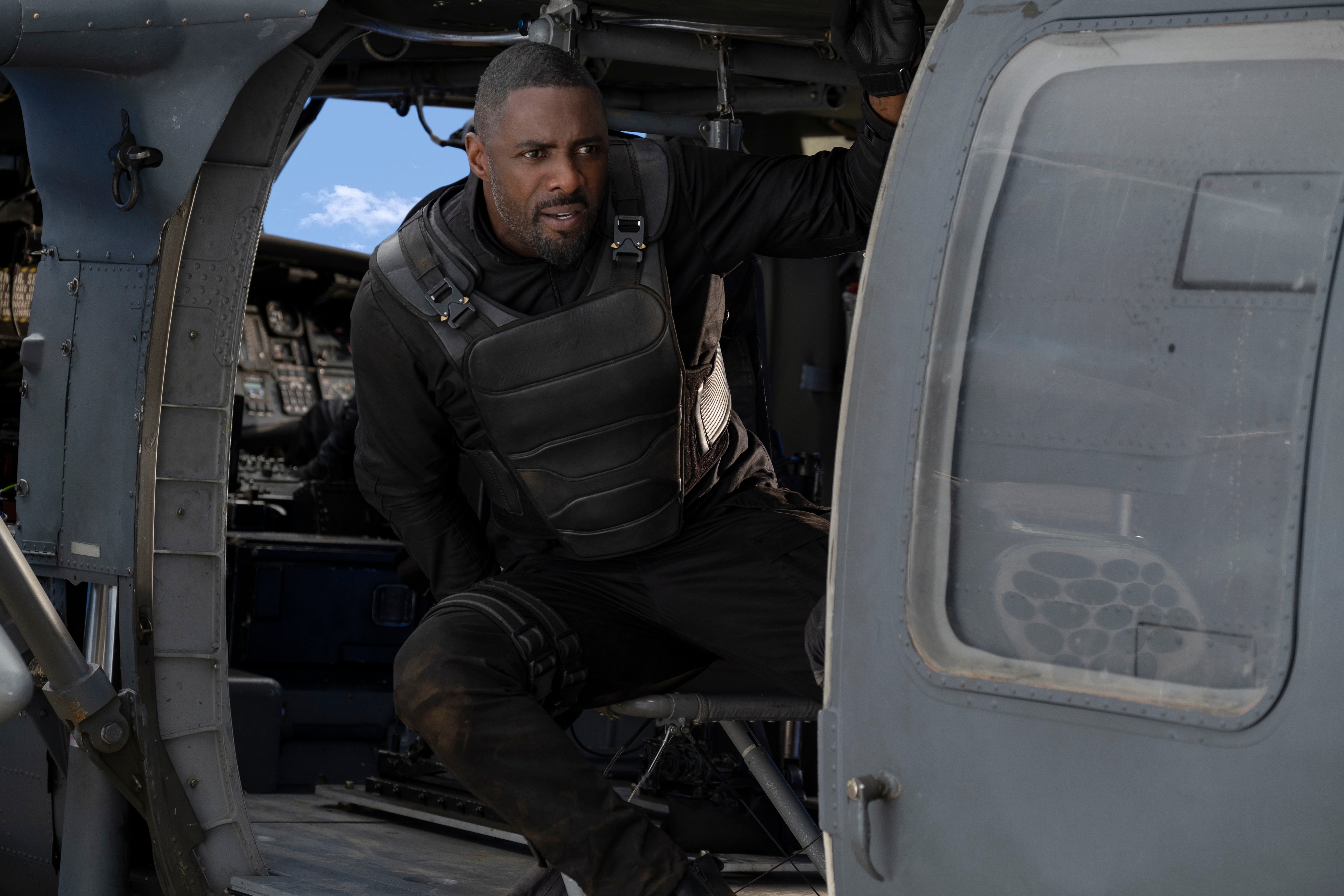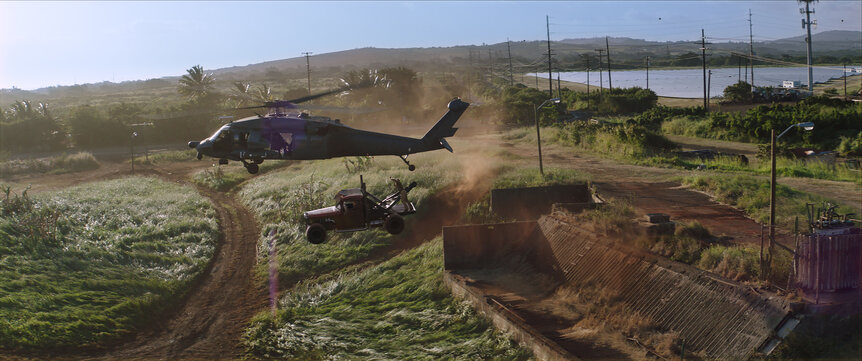Create a free profile to get unlimited access to exclusive videos, sweepstakes, and more!
The Hobbs & Shaw helicopter finale was more real and practical than you'd think

The final major action sequence of Fast & Furious Presents: Hobbs & Shaw acts as a gigantic expression of the franchise's core tenets: Go fast, make things go boom, and ride or die with your family.
Set on the island of Samoa and split between a huge front yard and stretch of cliffs overlooking the Pacific Ocean, the sequence features a ring of fire, timed explosions, a chain gang of souped-up trucks, and an expertly flown helicopter rigged to the train of pickups. As with any modern action movie, there is plenty of CGI on the screen throughout the sequence, but thanks to director David Leitch, the Hobbs & Shaw finale in the sky was as practical as possible.
The first part of the scene takes place in the massive front yard of the Hobbs family home, to which muscle-bound government agent Luke Hobbs (Dwayne Johnson) has just returned for the first time in two decades. It takes a day or so, but Hobbs makes peace with the family he has avoided for all those years, a detente that comes just in time for him and temporary partner Deckard Shaw (Jason Statham) to lure the villainous semi-cyborg Brixton (Idris Elba) to the island for a massive showdown.
The multi-stage battle starts with the explosion in the yard, temporarily penning in Brixton's mercenaries with a wide circular perimeter of fire. Inevitably, Brixton and his surviving special forces henchmen make it out of the ring of death and follow Shaw, Hobbs, and his many brothers and cousins to the cliffs, where the trucks go to war with a souped-up Blackhawk helicopter.
It would be impossible for the sequence to be made without plenty of special effects, but Leitch was hired on the film in part for his expertise on massive practical stunt work. He spent years as a stunt and fight coordinator before making the leap to directing action flicks, beginning with John Wick (which he co-directed with Chad Stahelski) and then on to Atomic Blonde and Deadpool 2. He took the sum total of that experience and deployed it in this, the first spinoff in the biggest action franchise in the world, with the finale serving as his submission to the series' blockbuster sequence hall of fame.
"When we were in Samoa, between the battle and between the driving, I had nearly 50 stunt performers there the whole time," Leitch told SYFY WIRE. "The stunt drivers that we had out there were some of the best in the business and guys that I've known for 25 years."
The sequence features the Hobbs family driving a procession of trucks across a dirt road, their lumbering frames zipping faster than seems possible thanks to the clutch use of the iconic Nos engine boost. One truck carries a huge chain, which they miraculously hook onto the helicopter. From there, the trucks begin to hook onto one another, so as to provide the weight that prevents the chopper from lifting them off the ground.
Some of the Samoan brothers were played by stunt drivers so that they could more easily feature in the monster chase. Their skills and discipline were very much necessary in such a precision-heavy scene. It was actually more dangerous for the drivers to be connected, so the chain was rendered in CGI. The rest — up to four trucks at a time — was shot on location.
"They're driving fender to fender like they're connected — they're just driving in formation where it feels like they're connected, and that's how good these guys are," Leitch raved about his longtime collaborators. There were about 20 stunt actors working on those trucks at any one time, a number that does not include the sheer amount of people working on the helicopter segments.
The Blackhawk helicopter, with Idris Elba inside, chases after the trucks from beyond the ridge and then flies over the procession to fire on the drivers. It would have been both financially and practically prudent to build the helicopter entirely in digital post-production, but that's not how Leitch flies. Instead, he hired Fred North, a veteran pilot who, incidentally, worked in the transportation department on Fast Five, to act as both helicopter pilot and the aerial stunt coordinator, choreographing the bird's movements in time with the trucks on the ground.
"The helicopter and any time the cars are on the ground or the cars are on two wheels, that's all practical stunt driving and effects. We built rigs where we could drive the trucks on two wheels," Leitch explained. "The Blackhawk helicopter is 95 percent real in all those shots, except for when it's doing maneuvers that would put everybody's life in peril."
While they obviously had to animate cars fully dangling from the chain attached to the helicopter, they went so far as to even keep the explosions that rock the helicopter as practical as possible. Hobbs and company planted mortars on the dirt road to explode when the chopper flies by; in the movie, they were exploding barrels meant to blow high enough to smack the helicopter, and while that was obviously not feasible on the set of a movie that did not want any casualties, there were *explosions* on set as they filmed that part of the sequence.
"We have practical mortars with smoke so we could get the rotor wash, and that was all real, and there's flame coming up [that was real]," Leitch said. "The barrels obviously had to be CG because you can't hit the helicopter. But the cars are real, the pyro is real, the helicopters are real, and you set up that sequence and you shoot that once, and then you'd wait for four hours and set it up and you do it again."
Luckily, it only required about two takes to get exactly what Leitch wanted.



























